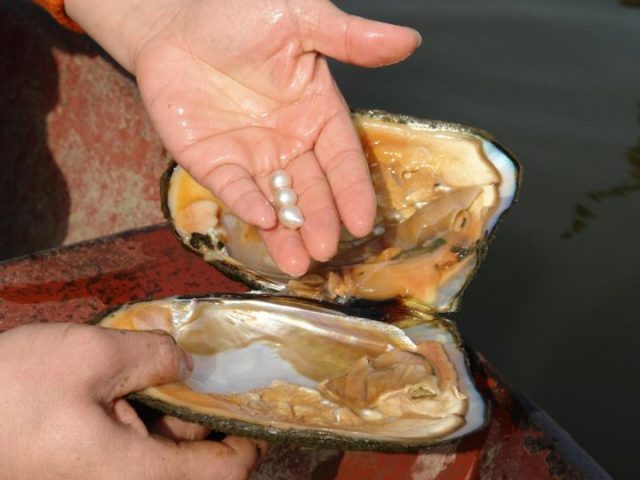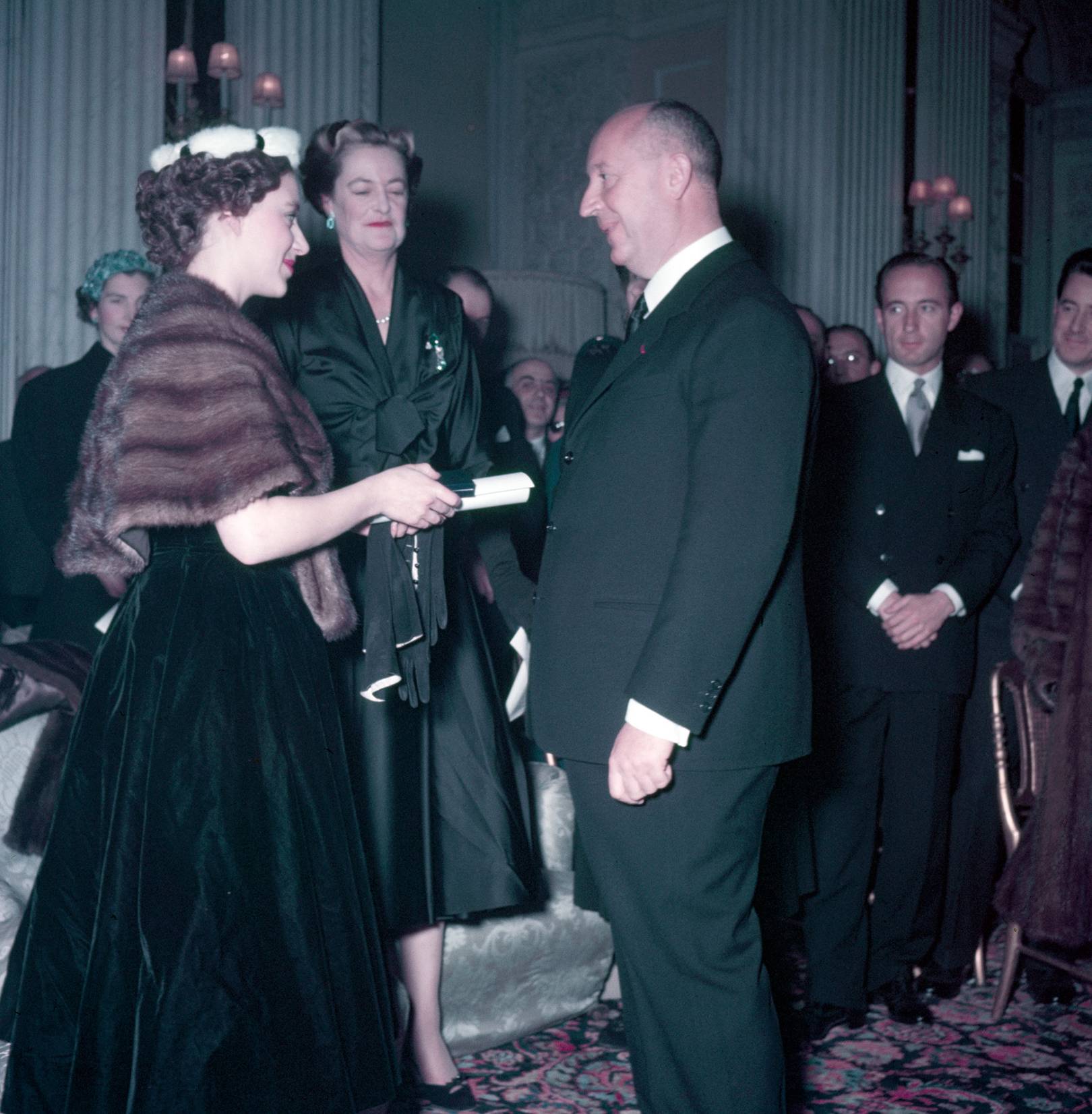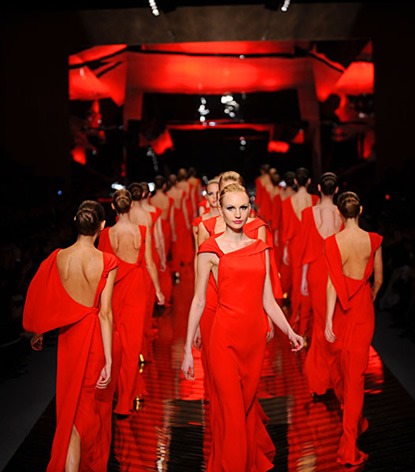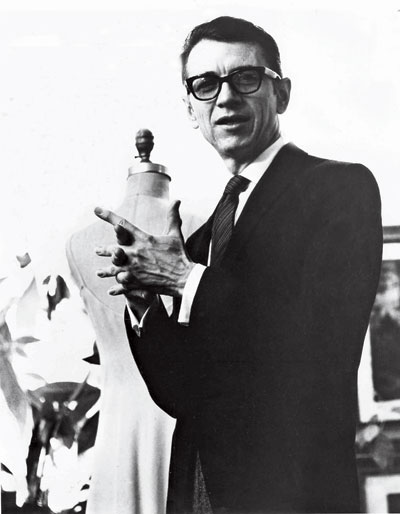talkingfashion » 1960s jewelry
-
Picturesque Pearls: A Style Guide
Picturesque Pearls: A Style Guide
By Paige McKirahan
With wedding season well on its way, we wanted to take a look at one of our favorite elegant motifs in accessories for these upcoming warm weather months. Since pearls first made their way into the realm of jewelry, they have been the true symbol of class and superiority; seeing has how the pearl is the world's oldest gemstone with traces back to 420 BC, this elitist undertone has deep historical roots. In the Byzantine empire, for example, it was dictated that only the emperor was permitted to wear pearls with other societies having similar laws. Until the 20th century, pearls were considered to be one of the most valuable gems on the market all over the globe; prior to this time, all pearls were naturally found in wild mollusks, making them more rare and coveted than ever.

Oldest pearl necklace in existence on display at the Louvre (source)
In ancient Greek culture and at the height of the Roman Empire, pearls were worn on gowns, necklaces, and were even used to decorate furniture in wealthy households. It was even said that Cleopatra preferred pearl jewelry above all others, and she went as far as dissolving one of her most priceless pairs of pearl earrings in a glass of wine before drinking it! This ancient popularity led to pearls being extremely favorable with the monarchy; pearls of all shape and color varieties were widely sought after, and many were coming directly from the Persian Gulf. The 16th century in England was even referred to as the Pearl Age, perfectly reflecting the gemstone's prestige at the time.

Cleopatra Dissolving the Pearl in Wine, Andrea Casali (source)
In the Victorian Age, seed pearls became more favorable than any of their counterparts on account of the fact that their small size made them perfect for jewelry and other accessories. They are typically no larger than 2mm in diameter, and they were widely associated with pure ideals. Royal love of pearls continued for generations, with Queen Victoria having an affinity for all things pearl. Prince Albert gifted her a pair of drop-style pearl earrings in 1847, and these are now owned and proudly worn by the reigning monarch, Elizabeth II.
It wasn't until the late 1800s that pearls became a widely accessible material; in 1893, Kokicho Mikimoto discovered how to create cultured pearls, prompting the creation of over 350 pearl farms across Japan by 1935. This caused a widespread pearl mania that perfectly complemented contemporary culture all throughout the 1900s. From Coco Chanel's iconic 1936 portrait to Audrey Hepburn's emblematic look in Breakfast at Tiffany's, pearls became a true symbol of luxury. This sophisticated aesthetic shifted with Alber Elbaz at the helm of Lanvin, where he reimagined the gemstones as a "cool girl" motif rather than something you would find in your grandmother's jewelry box. He truly spun their reputation into something journalists felt were "not like your mother's pearls", and the gemstone has been present in haute couture ever since.


Coco Chanel and Audrey Hepburn in pearls (source)
Now that we know the history behind the eponymous stone, its time to evaluate the types of pearls. They can now be produced in a variety of different ways, with each having its own special set of characteristics! Whether they are natural or cultured, they are formed when a mollusk produces layers of nacre around molecules inside of the shell. The quality of the nacre is what controls the level of the pearls shine, which can cause it to decrease or increase in value. High-quality pearls should be smooth and blemish free, with shapes ranging from round to misshapen. Misshapen pearls are considered to be baroque, after the art movement. Lastly, a pearl set in necklaces can be uniform with all pearls at the same size, or graduated, meaning they change uniformly from the end to the center. With this education in mind, let's take a look at the specific types of pearls on the market!

(source)
Natural Pearls
Natural pearls are the rarest type, with many historically being found in the Persian Gulf. Though many have already been harvested, you may be able to purchase these small gemstones, but they will cost you a pretty penny!
Cultured Pearls
Cultured pearls are grown in farms, with the mollusks containing them being raised until they reach the point of being able to accept the mother-of-pearl bead nucleus. The pearl technician then implants the bead and returns the mollusk to water to form the gem. Not all cultured pearls are of high quality, and it can take tens of thousands of pearls to compile a group similar enough to use in jewelry.
Saltwater Pearls
Many countries grow cultured pearls in their saltwater seas. Japan and China produce cultured pearls that can range from 2 mm to 10mm in size, and are usually white in color. Australia, Indonesia, and the Philippines produce the largest of all cultured pearls. They are considered the "South Sea pearl" and can get up to 20 mm with colors ranging from white to cream to gold. There are also saltwater pearls grown in the islands of French Polynesia, with their sizes ranging from 8mm to 16mm. They can be naturally black, but they typically can be gray, blue, green, or purple.
Freshwater Pearls
Freshwater pearls mostly hail from China and are grown in lakes, rivers, and ponds all over the continent. Many are white and similar in size to Akoya pearls in size and shape, and usually, have a thicker nacre on account of them not having a bead nucleus.
Imitation Pearls
Imitation pearls usually have a high luster and are coated glass beads. You can tell these apart from cultured or natural pearls, but it may prove to be difficult based upon how the pearls were treated. For tips on how to analyze your pearls, click here!
We hope that this gave you a better insight into all things pearls! We now have a little bit of pearl mania and if you do too, be sure to check out our selection of pearl accessories!
Sources:
Luna, B. (2015, August 10). The History Of Pearl Jewelry. Retrieved from https://www.ritani.com/blog/gemstone-jewels/the-history-of-pearl-jewelry/Perron, C. (2017, December 08). The History and Symbolism of Pearl Jewelry. Retrieved from https://www.brilliantearth.com/news/the-history-and-symbolism-of-pearl-jewelry/N/A. (2018, June 08). The Evolution of Pearl Jewelry in Fashion. Retrieved from https://www.crfashionbook.com/fashion/a21098608/pearl-jewelry-fashion-history/ -
Designer Spotlight: Christian Dior
Designer Spotlight: Christian Dior
By Paige McKirahan
As a household name in both the fashion world and among creatives alike, Christian Dior was the obvious choice for our designer spotlight this week. This French couturier was born on the coast of Normandy in 1905 as one of five children born to a wealthy fertilizer manufacturer. He moved to Paris at the age of 5 and used his artistic inclinations to sell his sketches on the streets for small change. Though his parents hoped that he would become a renowned diplomat, he was adamant about pursuing his art, prompting his father purchased a small art gallery for him to take over after he completed school. The gallery held a variety of artistic works by artists like Pablo Picasso and tiny but mighty gallery saw small success. Despite this, Christian was forced to close its doors in the wake of the Great Depression in 1929, the deaths of his mother and brother, and the demise of his father’s business.

Christian Dior Art Gallery (source)
Following this event, Christian began working with fashion designer Robert Piguet and did so for around 10 years until he was chosen for military service in 1940. He served for two years and then went to work with couturier Lucien LeLong who dressed the wives of Nazi officers and French collaborators in order to preserve the industry’s economic and artistic prosperity. During this time, Christian was the primary designer at LeLong’s fashion house and worked alongside Pierre Balmain which, as you may have guessed, is the founder of the Balmain fashion house created in 1946.
After working with and under some of the industry’s most prevalent names, Christian decided he was going to found his own fashion house; in December 1946, he founded the house of Dior in Paris and was backed by Marcel Boussac, a cotton-fabric Magnate. Many say that the house was not truly open until 1947, which is when Christian debuted his first collection.

New Look design from first Dior Collection (source)
This first collection, containing 90 different looks, was considered the pinnacle of the “New Look” as defined by US Harper's Bazaar magazine editor Carmel Snow. His designs were not aligned with the wartime fabric restrictions and featured calf length, full skirts, cinched waists, and fuller busts. The look garnered some criticism on account of its overall opulence, but it was this lavishness that allowed Paris to re-establish itself as a head player in the fashion world.
His was an immediate success and was overwhelmed with orders from world-famous icons like Rita Hayworth and Margot Fonteyn. The British Royal family even invited Christian to have a private showing of his collection despite the fact that King George V barred young princesses Elizabeth and Margaret from wearing his controversial New Look pieces. After he became an established name in the industry, he established his ready-to-wear house on New York’ 5th Avenue in 1948 as the first of its kind. His debut perfume line launched in 1948 as well with Miss Dior being his first fragrance, which was named after his sister.

Christian meeting Princess Margaret (source)
Not to be outdone by any of his counterparts, Dior was the first haute couture brand to license the production of its designs beginning in 1949. Christian realized that his New Look pieces worked hand in hand with one another and he along with his business partner Jacques Rouet saw the importance in licensing his name to an array of luxury accessories including furs, hats, stockings, and ties. This decision was met with great criticism as it was said to “cheapened the haute couture industry”. Regardless, his massive success with the endeavor inspired nearly all other couturiers to follow the same model.
In 1955, Dior hired 19-year-old Yves Saint Laurent as his design assistant and almost immediately knew that Laurent would be the one to succeed him at Dior. He told Laurent’s mother this at the age of 52 and she was quite confused about the remark until he suffered from a fatal heart attack in October of 1957 shortly after his meeting with her. His funeral saw over 2,000 attendees that included his staff and multitude of famous clients with the Duchess of Windsor at their head.
In the wake of Christian's death, Rouet appointed 21-year-old Laurent as the house’s artistic director in an effort to counteract the disarray caused by the event. He held the position until he was drafted and was succeed by Marc Bohan who defined a new era and silhouette for Dior that is known as the Slim Look. This modernized, sleek version of Christian’s iconic look proved to be a hit in the industry and he was an artistic director until 1989. Gianfranco Ferre followed him and then was replaced by John Galliano in 1997 as he was said to have a creative talent that aligned perfectly with Christian’s. Ferre and Galliano transformed the designs and Dior’s ready-to-wear lines shot up in popularity. Galliano’s name was plastered on headlines everywhere when fashion and philanthropic icon Princess Diana wore his first couture dress for the brand.

St. Laurent design for Dior, 1955 (source)
Galliano also was a pioneer in using branded logo motifs and he used that design to create his now iconic saddlebags that were in the hands of every it girl of the era. His brilliant work dazzles but also brought controversy, and he was eventually removed from his position after making anti-Semitic statements on film after a wild night out. Raf Simons then was appointed to the role of artistic director and was a great success from 2012 to 2016. After his departure, the decision surrounding who would succeed him was difficult but game-changing; Maria Grazia Chiuri, the former Valentino co-creative director, took over operations at Dior as the first female to hold the position. Her unapologetic approach empowers women and ensures the brands' success for years to come! We may not have any Dior in store, but we do have a great Saint Laurent piece sure to sate your designer appetite!
Sources:
Bannerman, S. L. (2018, July 19). The History of the House of Dior. Retrieved from https://theculturetrip.com/europe/france/articles/the-history-of-the-house-of-dior/
Sowray, B. (2017, August 23). Christian Dior. Retrieved from https://www.vogue.co.uk/article/christian-dior
-
Fur in Fashion: Faux Pas or Fabulous?
Fur in Fashion: Faux Pas or Fabulous?
By Paige McKirahan
One material that has been on trial in fashion court for decades is one that was, for a large portion of its life, associated with high status and class. Fur accessories and clothing have been in circulation for 170,000 years and were used as a status symbol in as early as the 11th century. European royalty sported fur coats, capes, and accessories commonly made from mink, sable, and chinchilla fur. This increase in fur wearing prompted the creation of laws that regulated which social classes were permitted to wear specific furs. Prior to this, furs were more so used out of utility; the real pelts offered warmth and comfort to people in primitive cultures, starkly contrasting their new popularized purpose.
As the desire for luxury furs increased over the next five centuries, so did the development of fur farms. In the Victorian era, we saw a rise in popularity with both genders as the use of furs in movies put a spotlight on the wild textile. Coats worn by men tended to be lined with fur with other materials covering the outside of the piece. Women’s coats boasted fur accents throughout at the collar, wrists, and hems. We also saw the popularity of dress and shoe clips begin to inflate in the same period; these accessories were either adorned with fur details or accessorized the fur pieces themselves.

Victorian Era Furs
(photo credits to grandladies.com)
Other accessories that loved fur fun were scarves, shawls, and hats. Looking back at their basic use surrounding warmth, people used fur to accessorize cold weather outfits in style. These small hints of luxury could elevate any look and were sure to illustrate the wearers high status.
The 1900s brought big change to the fur industry as imitation furs began to take over the market. Real furs were expensive and many fashionistas, especially animal rights activists, associated them with cruelty. As technology improved, so did the quality of fake furs created from silk and synthetic pile fabrics. Designers began to create more casual looks using fur, moving away from glamour and more towards department store chic. The ’50s and ‘60s saw fur be more affordable than ever, with faux fur options being front and center on account of Old Hollywood influence.

1950s Fur Ad
(photo credits to vintagedancer.com)
Now, fur is still one of the most widely debated fabrics in the industry and and increased amount of high profile brands are declaring themselves as fur free. The ‘90s pushed the faux v. real fur debate and used iconic supermodels as spearheads for the movement away from a fur-filled future. Fendi seems to be at the center of this debate as their haute couture counterparts seem to be ahead in the faux fur conversation; Gucci and Versace have vowed to ditch the real thing, while Fendi continues to unapologetically create pieces with real animal fur. Whatever style you prefer, we encourage you to research furs and the benefits of both styles before deciding on a side! Remember to wear what you love, and find fur items you love in our collection!
-
History of Valentino
History of Valentino
By Paige McKirahan
There are few words that you think of when you hear Valentino, and most of them are associated with luxury. This haute couture label is one of the top fashion brands in the world and has been seen on industry magazines, runways, and red carpets around the globe. Everyone from the likes of Elizabeth Taylor to Naomi Campbell have been seen in these designs and with such a high profile presence in not only the fashion industry, but in the luxury industry as well, you would expect a history that lives up to fame. Valentino Garavani, the creator of the fashion house, made sure that in not only lived up to those expectations, but exceeded them.

(photo credits to wwd.com)
Garavani, an Italian native, was born in Voghera in 1932. He had an affinity for fashion starting at the beginning of his life, and eventually went on to study design in Paris at the beginning of 1950. He then was hired for his first design position with Jean Desses, and worked for them until 1967 when he obtained a position with Guy Laroche in his new atelier. After working there for two years and improving his taste and his technical skills, he returned to Italy and opened his own fashion house. At the end of 1957, he debuted his first haute couture collection and his refined lines and sophisticated aesthetic garnered great praise from publications like the Sunday Times in London.

Valentino with his collection for Guy Laroche in 1967
(photo credits to her.ie)
In the following three years, he quickly became the favorite of those in the “new Hollywood”, or Cincecitta, during great economic success in Italy. One of the first big names to wear a Valentino design was Elizabeth Taylor during her time filming Cleopatra in Rome. His collection for fall/ winter in 1961 boasted garments inspired by Jacqueline Kennedy, which only increased his growing global fame. His superstar status was secured after his 1962 show in Florence; the designs were so dazzling that he became the first Italian designer to have a French Vogue cover created in their honor.

Valentino 1961
(photo credits to pinterest.com)
His fall/ winter collection for 1963, which featured wild animal motifs, landed him in the pages of American Vogue, launching his popularity in the American market. The 1966 Valentino collection has become famous for its pop-art inspired pieces, which were aligned with the iconic movement during that decade. The 1960s proved to be quite prosperous for the brand as the designer’s pieces and accessories, especially his handbags sporting the luxurious gold “V”, were considered to be fundamental parts of a jet setting woman’s wardrobe. 1968 saw critical moments for the label; its spring/ summer line that year contributed to the dissipation of a haute couture crisis that involved people looking at less exclusive models. Following the show, shops opened up in Paris and Milan and later that year Valentino designed Jacqueline Kennedy’s wedding dress. These events made Garavani the most acclaimed designer in the industry at that and set the tone for the rest of his time with the brand.

(photo credits to pinterest.com)
The 1970s brought experimental changes; a boutique line was created alongside of the Valentino label itself, and both lines adopted an art deco aesthetic. The brand’s first namesake perfume was released in 1978, and it was followed by a line of blue jeans that made their debut at none other than Studio 54. Moving into the ‘80s, we see the rise of the famous Valentino red accompanied by classic black and whites; the silhouettes included a variety of draping, ruching, and dramatic details. The ‘90s saw a decade of celebrations for the brand’s 30 years in fashion through a series of films, books and exhibitions. Valentino himself sold the brand to Holding di Partecipazioni Industriali SpA (HdP) in 1998, but remained the creative director until his retirement in 2008; his last show was at the Musee Rodin in Paris and featured the most iconic set of supermodels from all of his decades in fashion. After Garavani’s retirement, Ferruccio Pozzoni and Alessandra Facchinetti took over his position and they were then succeeded by Maria Grazia Chiuri and Pierpaolo Piccioli shortly after, who still director the label today.

From Valentino's last show as creative director, 2008
(photo credits to loveofvalentino.blogspot.com)
Valentino has seen a wide collection of iconic accessories ranging from heels to bags. As I said before, the iconic “V” bag was a staple in womens closet and established the house as an essential brand. The Valentino Rockstud heel is quite possibly the most iconic piece to come out of the brand; these studded, strappy stilettos have been a favorite of street style aficionados and have inspired an entire line from the brand. This newfound studded fame reignited the brands popularity and has brought Valentino back to the forefront and into the closets of millions. Check out our favorite Valentino piece in our collection and gift yourself some classic red couture this holiday season!
-
The Master of Bias: Charles Kleibacker
The Master of Bias: Charles Kleibacker
By Paige McKirahan
Though there have been many iconic designers in the past century that have made a substantial mark on the fashion world, Charles Kleibacker may be the most enigmatic. Born in 1921 in Alabama, this American creator earned his nickname “Master of Bias” because of his affinity for complex gown designs involving cuts diagonal to the weave. Despite his iconic status in the fashion world, Kleibacker wasn’t always so well versed in the industry; he attended the University of Notre Dame and majored in journalism, which lead him to attend New York University for his graduate studies.

Kleibacker in 1565
(photo credits to threadmagazine.com)
He eventually relocated to California and met singer Hildegarde in San Francisco after running into one other in the same hotel. His large station wagon landed him a job as her driver and he toted around her and her entourage on tour all around the globe. It was in Europe when he finally realized his love for fashion after meeting a multitude of fashion designers through Hildegarde. His interest was piqued while in the offices of Christian Dior, and this prompted him to submit a set of early designs that earned him a spot at Lanvin in 1954. He worked there for three years and promptly returned to New York to work for Nettie Rosenstein, on the most highly regarded American fashion designers of her time.

Kleibacker for Lanvin, 1967
(photo credits to pinterest.com)
In 1959, he moved out of the shadow of others and into his own light when he began designing his own collection out of his brownstone in the Upper West Side. The line was a huge success and by the mid ‘60s, he was creating pieces for some of the most exclusive luxury clothiers including Henri Bendel and Bergdof Goodman. His trademarks were silk and wool crepe and of course, the bias cut; this special practice created designs that had a true cut look, not one that appeared stamped out.

Kleibacker designs
(photo credits to garmentozine.wordpress.com)
After his great success in New York, Kleibacker came to Ohio and became a Designer- in- Residence at The Ohio State University’s Costume and Textiles Collection. His work was a part of a 2005 exhibit there in the College of Human Ecology. He then became an adjunct curator of design at the Columbus Museum of Art and organized multiple fashion related exhibits. He remained there until the time of his death in 2010, when he passed away due pneumonia at 88 years old. Our very own CEO had the pleasure of working closely with him on multiple local fashion shows and events, making him also a close companion of our brand here at TalkingFashion. As an amazing designer so close to our home office, we felt it would only be appropriate to celebrate his wonderful life; one with a nickname like “Master of Bias” is hard to forget.
Sources:
Charles Kleibacker. (2018, October 06). Retrieved from https://en.wikipedia.org/wiki/Charles_Kleibacker





